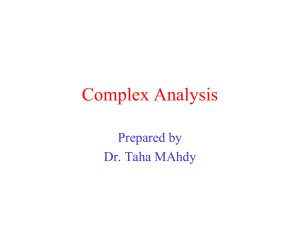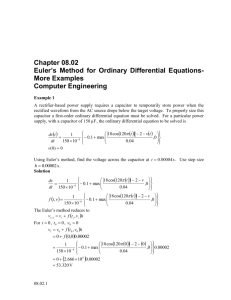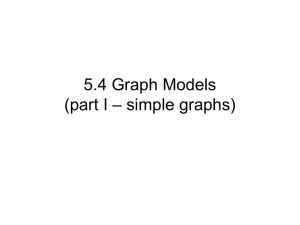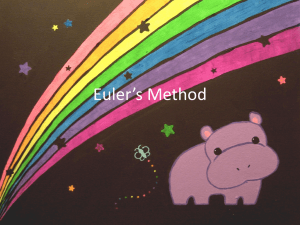E-72 Series paper
advertisement
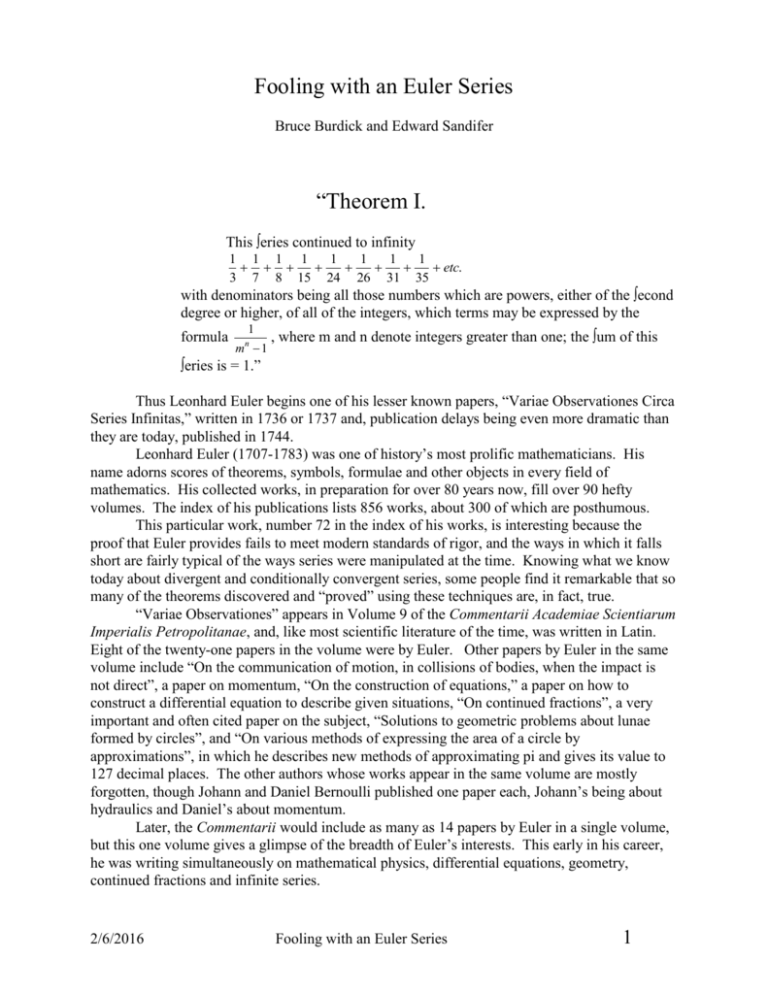
Fooling with an Euler Series
Bruce Burdick and Edward Sandifer
“Theorem I.
This eries continued to infinity
1 1 1 1
1
1
1
1
etc.
3 7 8 15 24 26 31 35
with denominators being all those numbers which are powers, either of the econd
degree or higher, of all of the integers, which terms may be expressed by the
formula
1
m 1
n
, where m and n denote integers greater than one; the um of this
eries is = 1.”
Thus Leonhard Euler begins one of his lesser known papers, “Variae Observationes Circa
Series Infinitas,” written in 1736 or 1737 and, publication delays being even more dramatic than
they are today, published in 1744.
Leonhard Euler (1707-1783) was one of history’s most prolific mathematicians. His
name adorns scores of theorems, symbols, formulae and other objects in every field of
mathematics. His collected works, in preparation for over 80 years now, fill over 90 hefty
volumes. The index of his publications lists 856 works, about 300 of which are posthumous.
This particular work, number 72 in the index of his works, is interesting because the
proof that Euler provides fails to meet modern standards of rigor, and the ways in which it falls
short are fairly typical of the ways series were manipulated at the time. Knowing what we know
today about divergent and conditionally convergent series, some people find it remarkable that so
many of the theorems discovered and “proved” using these techniques are, in fact, true.
“Variae Observationes” appears in Volume 9 of the Commentarii Academiae Scientiarum
Imperialis Petropolitanae, and, like most scientific literature of the time, was written in Latin.
Eight of the twenty-one papers in the volume were by Euler. Other papers by Euler in the same
volume include “On the communication of motion, in collisions of bodies, when the impact is
not direct”, a paper on momentum, “On the construction of equations,” a paper on how to
construct a differential equation to describe given situations, “On continued fractions”, a very
important and often cited paper on the subject, “Solutions to geometric problems about lunae
formed by circles”, and “On various methods of expressing the area of a circle by
approximations”, in which he describes new methods of approximating pi and gives its value to
127 decimal places. The other authors whose works appear in the same volume are mostly
forgotten, though Johann and Daniel Bernoulli published one paper each, Johann’s being about
hydraulics and Daniel’s about momentum.
Later, the Commentarii would include as many as 14 papers by Euler in a single volume,
but this one volume gives a glimpse of the breadth of Euler’s interests. This early in his career,
he was writing simultaneously on mathematical physics, differential equations, geometry,
continued fractions and infinite series.
2/6/2016
Fooling with an Euler Series
1
Theorem 1 is the first of nineteen theorems and seventeen corollaries Euler presents in
this twenty nine page paper. All of these other results are, in fact, corollaries of this first result.
Typical among the other results is
“Theorem 10: If is taken to denote the perimeter of a circle which has its diameter = 1, then
3 80 224 440 624 728 etc.
32 81 225 441 625 729 etc.
where the numbers in the denominator of this expression are the squares of the odd numbers
which are not prime, and the ones in the numerator are the numbers one less.”
Euler attributes Theorem 1 to his boss, Christian Goldbach, though Euler apparently
claims the proof as his own. His proof goes as follows:
“PROOF:
1 1 1 1 1 1 1 1
2 3 4 5 6 7 8 9
1 1 1 1
1
Since 1 etc. , subtracting this from the first series gives
2 4 8 16 32
1 1 1 1 1 1
x 1 1 etc. , where the denominators exclude all those numbers which are
3 5 6 7 9 10
Let x 1 etc.
powers of two, but where all the other numbers occur.
From this last series, subtract this
1 1 1 1
1
1
etc.
2 3 9 27 81 243
and there will remain
x 1
1
1 1 1 1 1
1 etc.
2
5 6 7 10 11
and then subtracting
1 1 1
1
etc.
4 5 25 125
and there will remain
x 1
1 1
1 1 1
1 etc.
2 4
6 7 10
And in a similar way, all the remaining terms can be eliminated, leaving
x 1
1 1 1 1 1
etc. 1
2 4 5 6 9
or
x 1 1
1 1 1 1 1 1
etc.
2 4 5 6 9 10
where the denominators of this progression are all the numbers which are not one less than
numbers which are powers. If this series is subtracted from the series assumed at the beginning
x 1
1 1 1 1 1 1 1 1
etc.
2 3 4 5 6 7 8 9
there remains
1
1 1 1 1
1
1
1
1
etc.
3 7 8 15 24 26 31 35
from which, therefore, the series in which the denominators are all the numbers which are one
less than powers of whole numbers, has its sum = 1. Q.E.I.”
2/6/2016
Fooling with an Euler Series
2
The modern reader will find this proof both elegant and inadequate. In two hundred and
fifty years, we have learned much about divergent and conditionally convergent series, and
proofs of the form “infinity minus infinity equals one” do not meet modern standards of rigor. In
fact, Euler and Daniel Bernoulli later contributed to our modern understanding. In 1771, in
volume 16 of the Novi Commentarii Academiae Scientariarum Imperialis Petropolianae, the
successor to the journal in which “Variae Observationes” appeared, sandwiched between two
Euler papers, one on calculus of variations and the other on improper integrals, Daniel Bernoulli
published a paper “On the summation of series which have inconsistent values and their
interpretation and use.”
In this paper, Bernoulli writes “Recurrent series are common that have sums that are
manifestly false in concreto, yet not absurd in abstracto.” He explains this statement with a
“simple example”, S=1-1+1-1+1-1…, which he evaluates in abstracto to be, variously, 1, 0, 1/2,
1/3 and 2/3.
The modern reader should be wondering if Euler’s Theorem 1 is true. Though we
do not know how standards of rigor may change in the next 250 years, we offer a modern proof
of the theorem. The theorem uses the Moebius function [2], (k), defined for any natural number
k, as follows:
1
R
|
( k ) S0
|T(1)
if k 1
if a | k for some a 1
if k p1 p2 ... pr , pi distinct primes
2
r
Our proof uses the definition of the Moebius finction and its property that, for all m>1,
(k ) 0 .
k |m
Theorem 1, revisited:
n 1 1 1 where S {a |a 2,b 2}
b
n S
Proof:
1
1
1I
G
F
Hn 1 n JK
n2
n(n1 1)
n2
1
n2
1 n1n
2
n1
m
n 2 m 2
2/6/2016
Fooling with an Euler Series
3
n (k ) , where is the Moebius function, and we are using the properties
m
n 2 m 2 k |m
k 2
of the Moebius function mentioned above.
This triple sum is absolutely convergent since the triple sum of the absolute values is
bounded by
n m ( (m) 1)
m
m
n 2 m 2
m 2
So we can rearrange the terms as follows:
n (k )
m
n 2 m 2 k |m
k 2
(k ) n1
jk
n2 k 2
j 1
(this particular step being just a little tricky)
(k ) n 1 1
k
n2 k 2
(k ) n 1 1
k
k 2
n2
n
1
p
p prime n 2
1
n
1
pq
p ,q distinct n 2
primes
1
n
1
pqr
p ,q ,r distinct n 2
primes
1
o
t
Now note that the set S is the union of the sets S P a p | a 2 for p prime, that the
o
t
intersection of any two of these sets is S p Sq a pq | a 2 , and so on. So, by the
inclusion/exclusion principle, we have
n
1
p
p prime n 2
1
n
p ,q prime n 2
1
pq
1
n
p ,q ,r prime n 2
1
pqr
1
n 1 1
nS
QED
2/6/2016
Fooling with an Euler Series
4
References:
1.
2.
L. Euler, (1744), Variae Observationes Circa Series Infinitas, Commentarii Academiae
Scientiarum Imperialis Petropolitanae, 9, 160-188, reprinted in Commentationes
Analyticae ad theoriam serierum infinitarum pertinentes, (1925) Opera Omnia, ser I, vol
14, 216-244.
I. Niven and H. S. Zuckerman, An Introduction to the Theory of Numbers, Wiley, New
York, 1960.
BURDICK:
Roger Williams University
Bristol, RI 02809
bruce@alpha.rwu.edu
SANDIFER
Western Connecticut State University
Danbury, CT 06810
Sandifere@wcsu.edu
2/6/2016
Fooling with an Euler Series
5



